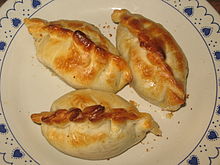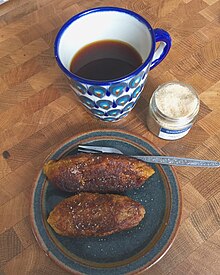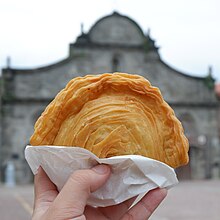Empanada
This article possibly contains original research. (April 2016) |
 Empanadillas from Spain | |
| Type | Pastry |
|---|---|
| Course | Appetiser, main course |
| Place of origin | Spain |
| Region or state | Galicia |
| Associated cuisine | |
| Main ingredients | Meat, cheese, corn, or other ingredients |
| Variations | Pastel, pasty |
An empanada is a type of baked or fried turnover consisting of pastry and filling, common in Spain, other Southern European countries, North African countries, Latin American countries, and the Philippines. The name comes from the Spanish empanar (to bread, i.e., to coat with bread),[1][2] and translates as 'breaded', that is, wrapped or coated in bread. They are made by folding dough over a filling, which may consist of meat, cheese, tomato, corn, or other ingredients, and then cooking the resulting turnover, either by baking or frying.
Origins
[edit]The origin of empanadas is unknown, but they are thought to have originated in 7th century Galicia, a region in northwest Spain.[3][4][5]
An empanada (empãada) is mentioned in the Cantigas de Santa Maria 57:VI (c. 1282):
Entr' esses roubadores / viu jazer um vilão / desses mais malfeitores, / ũa perna na mão / de galinha, freame / que sacara com fame / entom dũ' empãada | que so um seu çurame/ comer quisera, / mais nom podera, / ca Deus nom queria.[6] In the midst of these robbers he saw lying there one of the most vicious of the rascals with a chicken leg in his hand. He had taken the cold morsel out of a pasty and was about to eat it under the cover of his cape. However, he could not, for God prevented it.[7]
Rabbinic Jewish books from the same period, including the Novellae of Asher ben Jehiel (1250-1327),[8] the Novellae of Yom Tov of Seville (c. 1260–1320),[9] the Orchot Chayyim of Aaron ben Jacob (c. 1250-1325)[10] and the Arba'ah Turim of Jacob ben Asher (c. 1270-1340) mention "inpanada" and "panada" as bread products containing fat, meat or fish on the inside.[11][12]
A cookbook published in Catalan in 1520, Llibre del Coch by Robert de Nola, mentions empanadas filled with seafood in the recipes for Catalan, Italian, French, and Arabian food.[13][14]
By country and region
[edit]Argentina
[edit]
Argentine empanadas are often served during parties and festivals as a starter or main course. Shops specialize in freshly made empanadas, with many flavors and fillings.
Every region of Argentina has its own characteristic variant. Those of Salta (salteñas) are small, juicy and spicy, and contain potatoes, peppers and ground chili. These are also popular in neighbouring Bolivia.
The Jujuy variant adds peas and garlic. Its filling is called recado and the repulgue (method of closing the empanada) simbado. The La Rioja variant includes hard-boiled egg, red bell pepper, olives, and raisins. In Jujuy, there are two variants: criollas and arabes. Those of Santiago are considered especially juicy. Those of Catamarca are similar but smaller. Tucumán is known for the empanada creole; an annual National Empanada festival is held in Famaillá. Those of Famaillá are made with matambre and fried in good fat, competing with the entreveradas (mixed-grated), in which the matambre is mixed with chicken breast, garlic, ground chili, hard-boiled egg and cumin. Those of Mendoza are large and include olives and garlic. Those of San Juan have a higher proportion of onion, making them juicier and slightly sweet. Olives are also common and sometimes fat is also added to the recado or the dough. In San Luis they are big, seasoned with oregano and hot pepper, and kneaded with pork fat. In Córdoba, they were called[when?] "federal cake" or empanadas de Misia Manuelita, famous because pears boiled in wine with cloves were added to their filling. Today they are not so sweet but it is tradition to sprinkle them with sugar. In Traslasierra they add carrots and potatoes. In the Litoral, where immigrants from various parts of the world predominated, Santa Fe, Entre Ríos and Corrientes fill them with river fish, such as surubí (catfish) or dorado, or with white sauce and Goya cheese. In the Cordillera of Patagonia, they are made with lamb and on the coast with seafood. In Buenos Aires, the Creole empanada is so important that it has been declared a Cultural Heritage of Food and Gastronomy by the Argentine Ministry of Culture.[15][16]
Belize
[edit]
In Belize, empanadas are known as panades. They are made with masa (corn dough) and typically stuffed with fish, chicken, or beans.[17] They are usually deep fried and served with a cabbage or salsa topping. Panades are frequently sold as street food.[18]
Brazil
[edit]
In Brazil, an empanada is called a pastel (pl.: pastéis) and consists of half-circle or rectangle-shaped thin crust pies with assorted fillings, fried in vegetable oil. The result is a crispy, brownish fried pie. The most common fillings are ground meat, mozzarella, catupiry, heart of palm, codfish, cream cheese, chicken and small shrimp. Pastéis with sweet fillings such as guava paste with Minas cheese, banana and chocolate also exist.
Chile
[edit]
Empanadas are a staple part of Chilean cuisine. Commonly consumed in large quantities during the country's national day celebrations, many Chileans consider this to be their most representative dish.[19] The most iconic variety is the oven-baked empanada de pino, which is filled with ground beef, minced onion, half or a quarter of a hard-boiled egg, and a single unpitted black olive.
Empanadas in Chile are eaten year-round and are either oven-baked or deep-fried; the latter is a popular street food.
Costa Rica
[edit]
In Costa Rica, an empanada is turnover usually made with nixtamalized (lime treated) masa (corn dough); nevertheless, it could be made with doughs of cassava (yuca), green or ripe plantain, in addition to wheat flour. The empanada can be pan fried, deep fried or baked.
The empanada can be filled with plenty of foods, although beef, pork or chicken meat, but also with cheese, palm heart or different kind of vegetable hashes (called picadillo) or refried beans are the most common ones. There are also sweet empanadas filled with tropical fruit marmalades (such as guava or pineapple), dulce de chiverre (a sweet jam of Cucurbita ficifolia, also known as chilacayote, alcayota, calabaza de cabello de ángel or cidra) or dulce de leche (manjar, arequipe or cajeta).
In the caribbean coast of Costa Rica, there are some kind of wheat flour empanadas similar to Jamaican beef patty, also found with chicken meat or vegetable filling (usually ackee); there are also sweet empanadas called "Plantain Tart" or "Plantintá" (made with ripe plantain jam filling) and "Pineapple Tart" (made with pineapple jam filling).
Cuba
[edit]In Cuba, empanadas are frequently enjoyed as snacks, appetizers, or main courses at parties and gatherings. In Havana, the most common variant is filled with picadillo or shredded chicken, often mixed with ingredients like cumin, garlic, onions, raisins, and green olives. Empanadas are also commonly eaten for dessert, including fillings such as guava paste and cream cheese. In Cuban cuisine, empanadas are almost always deep-fried.
Ecuador
[edit]Empanadas de viento or "windy" empanadas are fried, wheat-based empanadas stuffed with stringy cheese and sprinkled with sugar. They have been given this appellation for their inflated appearance as if they have been filled with air.[20] Empanadas de viento can be made in cocktail size, appetiser size, and giant size, which is popular among the middle and working class. They are often eaten with coffee or with té de hierba luisa or lemon verbena tea. Their appearance is very similar to an Italian panzerotto.
Empanadas can be purchased from food stalls, markets, and restaurants. During religious holidays, women from the countryside fry empanadas at home and sell them in front of churches.
Empanadas de verde or plantain empanadas are plantain-based and filled with cheese and fried. These empanadas are most commonly found in the coastal regions of the country.
With the growth of Southern Cone and Colombian immigrants, wheat- and meat-based baked empanadas and corn-based empanadas have also become popular.
El Salvador
[edit]
El Salvador is one of few countries where the empanada is made with plantain rather than a flour-based dough wrapping.[21] A popular sweet variation, empanadas de platano are torpedo-shaped dumplings of dough made from very ripe plantains, filled with vanilla custard, fried, then rolled in sugar.[22] They may alternatively have a filling made from refried beans rather than milk-based custard, but the flavour profile remains sweet rather than savoury.[23][24]
France
[edit]In France, the traditional chaussons are made with a puff pastry dough filled with stew such as daube or confit, or a bechamel sauce mixed with ham and/or cheese.[25] They also exist in sweet version (see chausson aux pommes). They are half-moon shaped. If the shape is rectangular they receive the name of friand. One regional version is the pâté lorrain, filled with pork meat cooked with wine and onions. All these versions are baked.
The fried versions can be made of puff pastry or shortcrust pastry and are called rissoles. The most famous is the rissole de Coucy, filled with meat or fish.
Galicia
[edit]
Galician empanada (Galician: empanada galega) is a variety of empanada and one of the most popular dishes of Galician cuisine, commonly served in the towns of Galicia during festivals and pilgrimages. It is prepared with a variety of fillings, including local seafood, sausage, and chicken. It can be served hot or cold. The origin of this preparation is determined in the preparation of cakes in embers that were initially made directly in embers until it evolved into a preparation in clay pots that give it its current characteristic round shape. The preparation is mainly homemade and is done in ovens, but nowadays it is common to find it for sale in bakeries or street stalls.
The history of this dish in the region dates back to the Visigothic era in the 7th century, when rules for their preparation were decreed.[26] The first referenced empanada used mushroom or chicken fillings.[27] The empanada was an ideal food for travelers because it is a covered preparation that prevented contact of the interior with the dust of the roads. Galician empanadas appear sculpted as early as the 12th century on the Portico of Glory in Santiago de Compostela.[28]
Indonesia
[edit]
In Indonesia, empanadas are known as panada. They are especially popular in Manado cuisine of North Sulawesi where their panada has a thick crust made from fried bread, filled with spicy cakalang fish (skipjack tuna) and chili, curry, potatoes or quail eggs. The panada in North Sulawesi was derived from Portuguese influence in the region.[29] The dish is similar to karipap and pastel, although they have a thinner crust compared to panada.
Italy
[edit]
The Sicilian 'mpanatigghi are stuffed, consisting of half-moon-shaped panzerotti filled with a mixture of almonds, walnuts, chocolate, sugar, cinnamon, cloves and minced beef.[30][31][32] These are typical of Modica, in the province of Ragusa, Sicily. They are also known by the italianized word impanatiglie or dolce di carne (pasty of meat).[33]
They were probably introduced by the Spaniards during their rule in Sicily which took place in the sixteenth century; this is suggested by the etymology of the name which comes from the Spanish empanadas or empanadillas, as well as the somewhat unusual combination of meat and chocolate, which occurs occasionally in Spanish cuisine.[30][31][34] In previous centuries, game meat was used in 'mpanatigghi; today beef is used.[30]
Philippines
[edit]
Filipino empanadas usually contain ground beef, pork or chicken, potatoes, chopped onions, and raisins (picadillo-style),[35] in a somewhat sweet, wheat flour bread. There are two kinds available: the baked sort and the flaky fried type. To lower costs, potatoes are often added as an extender, while another filling is kutsay (garlic chives).

Empanadas in the northern part of the Ilocos usually have savoury fillings of green papaya, mung beans, and sometimes chopped Ilocano sausage (chorizo) or longaniza and egg yolk. This particular variant is fried and uses rice flour for a crunchier shell.[36] Empanadas can also be filled with mashed eggplant, scrambled eggs, and cabbage, which is called poqui poqui.[37]

In Bulacan, empanada de kaliskis (lit. 'fish scale empanada'), uniquely has a flaky multilayered crust resembling scales, hence the name. In Cebu, empanada Danao is a characteristically sweet-savory variant. It is filled with chopped chorizo and chayote, deep-fried, and dusted in white sugar before serving. In Zamboanga, empanada Zamboangueño is filled with chopped sweet potato, garbanzo beans, and served with a sweet vinegar dipping sauce.[38]
Dessert versions of empanadas also exist, notably empanaditas, which commonly have a filling of latik (coconut caramel), honey and nuts, or peanut butter. Kapampangan versions of empanaditas have a yema (custard) and cashew nut filling. In Cebu, sinudlan empanada is a small deep-fried empanada with bukayo (sweetened coconut meat) filling.[38]
Puerto Rico
[edit]In Puerto Rico, empanadas are made of a flour base and fried, and are known as empanadillas. Common fillings include meat such as ground beef picadillo, pork, chicken, pizza[39] (marinara sauce and cheese), guava and cheese, jueyes (crab), chapín (Spotted trunkfish), rabbit, octopus, and much more depending on local cuisine.
United States
[edit]Empanadas, mainly based on South American recipes, are widely available in New York City, New Jersey, Baltimore, Philadelphia, Washington, D.C., and Miami from food carts, food trucks, and restaurants.[40] Empanadas are usually found in U.S. areas with a large Hispanic population, such as San Antonio,[41][42] Los Angeles,[43] and San Francisco.[44]
Venezuela
[edit]
Traditional Venezuelan empanadas are made with ground corn dough, though modern versions are made with precooked corn. The dough may have a yellow color when toasted due to the addition of annatto. The fillings are very diverse, with the most conventional being cheese, shredded beef, chicken, cazón (school shark) in the Margaritan Island region especially,[45][46] ham, black beans and cheese (commonly called dominó) and even combinations of mollusks. The empanadas have a half-moon shape and are fried in oil. Sometimes, they may have more than one filling, such as in empanadas de pabellón,[47] which are made with a shredded beef filling (or cazón in the Margarita Island region), black beans, slices of fried plantain, and shredded white cheese.
Similar foods
[edit]The empanada resembles savory pastries found in many other cultures, such as the molote, pirozhki,[48] calzone,[48] samosa,[48][49] knish,[48][49] kreatopitakia,[48] khuushuur, Jamaican patty and pasty.[49]
In most Malay-speaking countries in Southeast Asia, the pastry is commonly called epok-epok or karipap (English: curry puff). Fried dumplings are found in Chinese cuisine (jiucai hezi and jiaozi) and in Vietnamese cuisine (bánh gối).
References
[edit]- ^ "empanar". SpanishDict. Archived from the original on September 29, 2022. Retrieved September 28, 2022.
- ^ ASALE, RAE-; RAE. "empanar | Diccionario de la lengua española". «Diccionario de la lengua española» - Edición del Tricentenario (in Spanish). Archived from the original on October 25, 2021. Retrieved January 20, 2022.
- ^ "Historia de la empanada criolla" (PDF). Dra. Susana Barberis. Archived (PDF) from the original on September 22, 2020. Retrieved July 8, 2010.
- ^ Penelope Casas (1982), The Food, Wines, and Cheeses of Spain, Alfred A. Knopf, New York 1982 (p. 52)
- ^ "Breve historia de la alimentación en Argentina". Liliana Agrasar. Archived from the original on September 17, 2019. Retrieved July 8, 2010. They first appeared in medieval Iberia during the time of the Moorish invasions.
- ^ Santalha, José-Martinho Montero. "Cantigas de Santa Maria (Texto crítico completo) (2021)".
- ^ Alfonso X, King of Castile and Leon (2000). Songs of Holy Mary of Alfonso X, the Wise : a translation of the Cantigas de Santa María. Internet Archive. Tempe AZ : Arizona Center for Medieval and Renaissance Studies. ISBN 978-0-86698-213-9.
- ^ b. Shabbat 40b
- ^ b. Shabbat 40b
- ^ f. 160v
- ^ "TurShulchanArukh – AlHaTorah.org". turshulchanarukh.alhatorah.org (in Hebrew). Retrieved July 11, 2023.
- ^ "TurShulchanArukh – AlHaTorah.org". turshulchanarukh.alhatorah.org (in Hebrew). Retrieved July 11, 2023.
- ^ Adamson, Melitta Weiss (2004). Food in medieval times. Greenwood Publishing Group. ISBN 0-313-32147-7. Archived from the original on April 6, 2023. Retrieved November 10, 2020.
- ^ Lady Brighid ni Chiarain. "An English translation of Ruperto de Nola's Libre del Coch". Stefan's Florilegium. Archived from the original on April 7, 2019. Retrieved January 31, 2011.
- ^ "Empanadas: su origen y una historia extensa". misionesalinstante.com. Archived from the original on January 9, 2021. Retrieved August 3, 2020.
- ^ "El mapa definitivo de las empanadas argentinas con sus 14 versiones". La Nación (in Spanish). October 5, 2018. Archived from the original on March 30, 2020. Retrieved August 3, 2020.
- ^ "Belizean Food". Belize.com. ITM Ltd. Archived from the original on May 27, 2024. Retrieved December 1, 2015.
- ^ Kraig, Bruce; Sen, Colleen Taylor, eds. (2013). Street Food Around the World: An Encyclopedia of Food and Culture. Santa Barbara, California: ABC-CLIO. p. 72. ISBN 978-1-59884-954-7.
- ^ Larrain, Jorge (2001). Identidad chilena. LOM Ediciones. ISBN 9789562823999. Archived from the original on April 6, 2023. Retrieved November 10, 2020.
- ^ "Empanada tradicional gallega". Lobby Market. April 27, 2023. Retrieved August 8, 2013.
- ^ Guillén, Alejandro (March 18, 2021). "Cultura y tradición: Empanadas salvadoreñas". Exclusiva Digital. Archived from the original on October 17, 2022. Retrieved October 17, 2022.
- ^ "Salvadorean Plantain Empanadas with Milk Filling". CocinAmerica. January 11, 2019. Archived from the original on November 28, 2021. Retrieved November 28, 2021.
- ^ "Empanada de plátano con frijoles". Recetas de El Salvador. Archived from the original on October 17, 2022. Retrieved October 17, 2022.
- ^ Morataya, Celina (March 24, 2014). "Empanadas Salvadoreñas Fuente: Recetas Salvadoreñas". Recetas Salvadoreñas. Archived from the original on October 17, 2022. Retrieved October 17, 2022.
- ^ Larousse, Librairie (August 30, 2022). Larousse Gastronomique: The World's Greatest Culinary Encyclopedia, Completely Revised and Updated. Clarkson Potter/Ten Speed. ISBN 978-0-593-57774-5.
- ^ Tejeiro. De la comida y otras sensualidades (in Spanish).
- ^ Cunqueiro. Cocina Gallega (in Spanish).
- ^ López Ferreiro. El Pórtico de la Gloria, Platerías y el Primitivo Altar Mayor de la catedral de Santiago (in Spanish) (1st ed.). Santiago de Compostela: Pico Sacro.
- ^ "Panada, Kue Lezat Peninggalan Bangsa Portugis di Manado". Archived from the original on March 8, 2021. Retrieved February 28, 2021.
- ^ a b c Red. Spe. (July 31, 2013). "Quanto è "dolce" Ragusa". Corriere del Mezzogiorno.
- ^ a b Giovanni Assenza (2014). Miele, garofano, cannella. I profumi dei dolci di Sicilia. Assenza. ISBN 978-605-030-594-4.
- ^ Nicky Pellegrino (2013). The Food of Love Cookery School. Hachette UK. ISBN 978-1-4091-3381-0.
- ^ Monica Cesari Sartoni (2005). Mangia italiano. Guida alle specialità regionali italiane. Morellini Editore. ISBN 88-89550-05-8.
- ^ Touring Club of Italy (2005). Authentic Sicily. Touring Editore. ISBN 88-365-3403-1.
- ^ Merano, Vanjo. "Picadillo Recipe". Panlasang Pinoy. Retrieved January 3, 2024.
- ^ Ian Ocampo Flora (April 23, 2010). "Vigan Empanada and the gastronomic treats of Ilocos". www.sunstar.com.ph. Archived from the original on May 5, 2010. Retrieved December 30, 2010.
- ^ Galiste, Ria (June 17, 2016). "Look: Restaurant adds twist to Ilocos empanada". ABS-CBN News. Archived from the original on May 31, 2019. Retrieved May 31, 2019.
- ^ a b Polistico, Edgie (2017). Philippine Food, Cooking, & Dining Dictionary. Anvil Publishing, Inc. ISBN 9786214200870. Archived from the original on April 6, 2023. Retrieved September 14, 2020.
- ^ "Empanadillas de Pizza – Kikuet". Retrieved January 4, 2024.
- ^ "10 Spots To Score Excellent Empanadas In NYC" Archived July 8, 2016, at the Wayback Machine by Angely Mercado, Gothamist, October 13, 2014;
"NYC Food Truck Lunch: Empanadas From La Sonrisa Empanadas" Archived February 24, 2021, at the Wayback Machine by Perry R., CBS New York, October 9, 2015 - ^ "The 15 Best Places for Empanadas in San Antonio". FourSquare. Archived from the original on March 8, 2021. Retrieved January 4, 2017.
- ^ Rice, Janae. "Finding Empanadas in SA". San Antonio Current. Archived from the original on February 25, 2021. Retrieved January 4, 2017.
- ^ Chabala, Tracy (July 18, 2013). "5 Great Baked Empanadas in Los Angeles". LA Weekly. Archived from the original on March 30, 2019. Retrieved January 4, 2017.
- ^ bayareabites. "Bay Area Bites Guide to Empanadas in San Francisco". KQED. Archived from the original on October 31, 2022. Retrieved October 31, 2022.
- ^ Suárez Rodríguez, Jesús M.; Almerich, Gonzalo; Gargallo López, Bernardo; Aliaga, Francisco M. (May 10, 2010). "Competencies in ICT of teachers and their relation to the use of the technological resources". Education Policy Analysis Archives. 18: 10. doi:10.14507/epaa.v18n10.2010. ISSN 1068-2341.
- ^ Parra, William (November 15, 2009). "El sistema penal acusatorio como comunicación universal y como parte del proceso de construcción de una cultura jurídica en Colombia, basada en el respeto de los derechos humanos". Criterios. 2 (2): 105–142. doi:10.21500/20115733.1907. ISSN 2011-5733.
- ^ "Hay masas de repostería que son húmedas o grasas y al estirarlas se quedan pegadas, aprende cómo evitarlo". CocinayVino.Net. Archived from the original on April 14, 2021. Retrieved April 15, 2021.
- ^ a b c d e Glenn Randall Mack & Asele Surina, Food Culture in Russia and Central Asia (Greenwood, 2005), p. 138.
- ^ a b c Patricia Yeo & Julia Moskin, Cooking from A to Z (St. Martin's Press, 2002), p. 53.
- Argentine cuisine
- Belizean cuisine
- Chilean cuisine
- Cuisine of the Southwestern United States
- Dumplings
- Ecuadorian cuisine
- Filipino cuisine
- Galician cuisine
- Guamanian cuisine
- Indonesian cuisine
- Italian cuisine
- Latin American cuisine
- Mexican cuisine
- Paraguayan cuisine
- Pascuense cuisine
- Portuguese cuisine
- Puerto Rican cuisine
- Savoury pies
- Spanish cuisine
- Stuffed dishes
- Tapas
- Uruguayan cuisine
- Venezuelan cuisine


